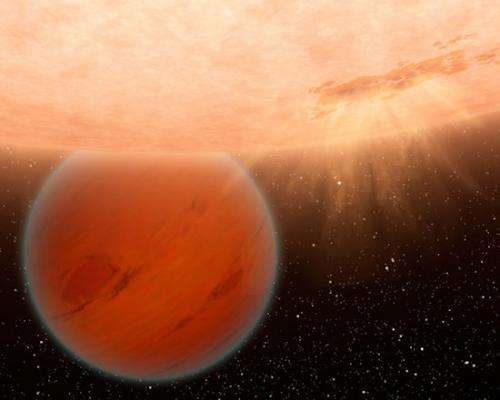The effect of starlight on the atmospheres of mini-Neptunes

Exoplanet surveys have discovered the first planets with sizes between 2 and 3.5 Earth radii—slightly smaller than the size of the planet Neptune in our solar system. These planets, dubbed "mini-Neptunes," have been spotted so far around five low mass stars, but since low mass stars are the most common stars in the universe, and since mini-Neptunes are also expected to be abundant around them, astronomers anticipate finding many more mini-Neptunes in the near future.
Since low-mass stars in general are redder than the Sun, and have lower surface temperatures, most of their flux is emitted in the optical and near-IR. Some of them, however, have active atmospheres that emit copiously in the ultraviolet. A star's ultraviolet radiation can have a significant effect on the atmosphere of any orbiting planets by dissociating molecules and thereby altering the atmospheric chemistry. Astronomers have calculated these effects for a few kinds of exoplanets, but the case of mini-Neptunes has never been explored. Since it now looks like they are likely to be abundant, CfA astronomers Lisa Kaltenegger and Sarah Rugheimer and two colleagues have calculated what happens when they are exposed to stellar ultraviolet, and compared their results to the atmosphere in one of the observed objects, the min-Neptune GJ436b, a relatively cool exoplanet with a surface temperature of about 640 kelvin.
The most abundant molecule in the atmosphere of GJ436b is thought to be molecular hydrogen, followed by water; the most abundant carbon-bearing molecule is methane, followed by carbon dioxide. (By comparison, in more massive exoplanets the primary carbon molecule is carbon monoxide.) The ultraviolet light from the star dissociates the water, and since water is a primary absorber of ultraviolet light its destruction allows for UV to penetrate deeper into lower layers of the atmosphere, producing a significantly different chemical structure, including affecting atomic oxygen abundance. The scientists find that the upper atmosphere of mini-Neptunes can be significantly altered by ultraviolet from the star, and future analyses cannot neglect to take this into account, but additional observations of mini-Neptunes are needed to refine the conclusions.
More information: "The Effect of Lyman α Radiation on mini-Neptune Atmospheres around M stars: Application to GJ 436b," Yamila Miguel, Lisa Kaltenegger, Jeffrey L. Linsky, and Sarah Rugheimer, MNRAS 446, 345, 2015. adsabs.harvard.edu.ezp-prod1.h … /2015MNRAS.446..345M
Provided by Harvard-Smithsonian Center for Astrophysics





















